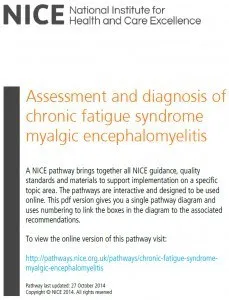This page is provided for your information only. A diagnosis of ME/CFS should be determined only by a suitably qualified medical professional, such as a GP or hospital consultant.
Myalgic encephalomyelitis (ME) is characterised by a range of neurological symptoms and signs, muscle pain with intense physical or mental exhaustion, relapses, and specific cognitive disabilities. Early reports dating from 1934 described epidemics of the illness – such as the 1955 outbreak at the Royal Free Hospital in London – but nowadays it is more common for endemic (sporadic) cases to be identified.
The World Health Organisation’s International Classification of Disease currently lists ME as a disorder of the nervous system, under Post-Viral Fatigue Syndrome (Block 93.3, ICD 10th revision, 2007). The 11th Revision (operational from Jan 2022) lists both ME and chronic fatigue syndrome, under Post-viral Fatigue Syndrome (Block 8E49, ICD 11th revision, 2019).
The cardinal symptoms of ME, as described in some of the early literature (see historical aspects and classic papers), are profound, generalised post-exertional loss of muscle power (fatigability); muscle pain that may include tenderness and swelling; and neurological signs. Patients are also prone to relapses which may take the form of recurrences of the original systemic illness, or fresh episodes of muscle weakness, neurologic changes or well-defined cognitive problems. As with many chronic illnesses, fatigue may be present, but in ME patients the fatigue is reported to be post-exertional, often delayed, and quite unlike the ‘fatigue’ experienced by healthy people.
What is ME/CFS?
During the 1990s, the term Chronic Fatigue Syndrome (CFS) came into use – see chronic fatigue syndrome for a more detailed description, including various diagnostic classifications.
As there was (and presently remains) no specific diagnostic test for myalgic encephalomyelitis (ME), and as post-exercise ‘fatigue’ was one of its prominent symptoms, people with ME began to be diagnosed with CFS. In recent years, however, there has been a growing recognition that the diagnosis CFS – based on a list of vague non-specific symptoms shared with other illnesses – is so broad that it can encompass a range of diverse patient groups. For this reason, there have been a number of attempts to devise a more sensitive way of diagnosing patients, including the Canadian Clinical working definition of ME/CFS (2003); and the ME: International Consensus Criteria (2011). In the United Kingdom, a clinical guideline for use by GPs was produced by NICE in 2007 (see below). Efforts to clarify diagnosis continue, however, and meanwhile the term ME/CFS is frequently used.
Of course, none of the issues surrounding the name alter the reality of the illness for thousands of people, and the lay term ME is still used by patients, patient groups and charities (including ME Research UK) to describe the illness affecting people diagnosed with ME/CFS, including that subgroup of CFS patients with an organic biomedical illness, neurological signs and symptoms.
ME/CFS today: the NICE Clinical Guideline
Most patients seeing a GP in the UK today are diagnosed using the criteria outlined in the NICE Clinical Guideline of 2007 (read the Guideline and supporting documentation here). This Guideline makes clear that the illness is recognised on clinical grounds alone (i.e. that there is no specific ‘test’ for the illness) and that healthcare professionals should consider the possibility of ME/CFS if a person has:
a) Fatigue with all of the following features:
- new or had a specific onset (that is, it is not lifelong),
- persistent and/or recurrent,
- unexplained by other conditions,
- has resulted in a substantial reduction in activity level,
- characterised by post-exertional malaise and/or fatigue (typically delayed, for example by at least 24 hours, with slow recovery over several days).
and
b) one or more of the following symptoms:
- difficulty with sleeping, such as insomnia, hypersomnia,
- unrefreshing sleep, a disturbed sleep–wake cycle,
- muscle and/or joint pain that is multi-site and without evidence of inflammation,
- headaches,
- painful lymph nodes without pathological enlargement sore throat,
- cognitive dysfunction, such as difficulty thinking, inability to concentrate, impairment of short-term memory, and difficulties with word-finding, planning/organising thoughts and information processing,
- physical or mental exertion makes symptoms worse,
- general malaise or ‘flu-like’ symptoms,
- dizziness and/or nausea,
- palpitations in the absence of identified cardiac pathology.
It is important to stress, however, that ME/CFS, whether defined by NICE or using another definition, remains a “diagnosis of exclusion”, which means that other possible causes of a patient’s symptoms should be excluded, often by testing, before this diagnosis is given. As the NICE Guideline says, “A diagnosis should be made after other possible diagnoses have been excluded and the symptoms have persisted for 4 months in an adult [and] 3 months in a child.
”
PLEASE NOTE – A positive diagnosis of ME/CFS can only be determined by a suitably qualified medical practitioner, such as your own GP or a hospital consultant.
What is the cause of ME/CFS?
The cause of ME/CFS is still unknown, but there is unlikely to be a single causative agent. Several past epidemics of ME appear to have been triggered by an outbreak of an infection with enteric organisms or poliovirus which then subsided, and still today many patients report an infectious onset to their illness. However, some people report a variety of contributing factors (including infectious, traumatic, environmental, etc.), all of which can lead on to a condition which shares a set of common symptoms.
Living with ME/CFS
Around 200,000 people in the UK and over 1 million in the USA have ME/CFS. The total affected by the illness is more than have HIV infection or multiple sclerosis, for example. Women are more likely to be affected than men, and ME/CFS affects all social groups and all ages, including children. Most patients are unable to work full-time, and up to a quarter of ME patients are housebound or bedbound. The course of the illness can be very variable; some people improve quite quickly but many others develop chronic illness lasting for many years. As the NICE Clinical Guideline says: “The physical symptoms can be as disabling as multiple sclerosis, systemic lupus erythematosus, rheumatoid arthritis, congestive heart failure and other chronic conditions”, and it identifies the following levels of severity:
Mild – where people “are mobile, can care for themselves and can do light domestic tasks with difficulty. Most are still working or in education, but to do this they have probably stopped all leisure and social pursuits. They often take days off, or use the weekend to cope with the rest of the week.”
Moderate – where people, “have reduced mobility and are restricted in all activities of daily living, although they may have peaks and troughs in their level of symptoms and ability to do activities. They have usually stopped work, school or college and need rest periods, often sleeping in the afternoon for one or two hours. Their sleep at night is generally poor quality and disturbed.”
Severe – where people, “are unable to do any activity for themselves, or can carry out minimal daily tasks only (such as face washing, cleaning teeth). They have severe cognitive difficulties and depend on a wheelchair for mobility. They are often unable to leave the house, or have a severe and prolonged after-effect if they do so. They may also spend most of their time in bed, and are often extremely sensitive to light and noise.”
There is no magic pill that can cure ME/CFS, but there are a number of approaches you can discuss with your GP or consultant. Pharmacological (drug) treatments are available for specific symptoms, such as sleep disturbance, pain relief, headaches, abdominal symptoms and disorders of balance. As regards energy management, many patients say that managing their activity, by pacing or other methods, helps them to live with the illness day-to-day, and a variety of coping strategies are available. These approaches can make a real difference, and help patients take back control of their lives until specific treatments are found for the underlying disease.
ME/CFS and disability
The Equality Act 2010 says a disability is a “physical or mental impairment which has a substantial and long-term adverse effect on your ability to carry out normal day- to- day activities.” The Act prohibits discrimination against certain people, including those with a disability. Protection applies in a range of circumstances, covering the provision of goods, facilities and services, the exercise of public functions, premises, in the workplace (including recruitment) and in education.
Although not treated as a disability automatically under the Equality Act, people with ME/CFS can be treated as disabled depending upon the effect the illness has on their daily life. ME is specifically listed amongst “impairments with fluctuating or recurring effects” in the 2010 Act Guidance document (pdf). Also, the Citizens Advice has produced advice on disability discrimination. Financial assistance may be available to those affected by ME – see Department for Work and Pensions website for more details.
The role of ME Research UK
ME Research UK exists to fund biomedical research into ME/CFS, to find its cause, to develop effective treatments and ultimately to discover a cure. In 15 years, it has funded 38 specific research projects in the UK and overseas, more than any other single organisation in the world outside the American continent. Read our ‘£1 million of Biomedical Research‘ for an overview of the research we have funded.
Reports and guidelines
- The NICE Guideline (2007) “
CFS/ME is a relatively common illness. The physical symptoms can be as disabling as multiple sclerosis, systemic lupus erythematosus, rheumatoid arthritis, congestive heart failure and other chronic conditions. CFS/ME places a substantial burden on people with the condition, their families and carers, and hence on society.
” - ME/CFS: A Primer for Clinical Practitioners (IACFS/ME) 2014 “
In this primer, the collected wisdom of many experienced clinicians and clinician-scientists has been gathered.
” - Scottish Good Practice Statement on ME/CFS (The Scottish Government 2010). Includes Clinical Guidance for medical practitioners, and a separate Guide for patients with ME/CFS.
- The Report to the Chief Medical Officer (2002) “
CFS/ME is a relatively common clinical condition, which can cause profound, often prolonged, illness and disability, and can have a very substantial impact on the individual and the family.
” - ME/CFS: Clinical Working Case Definition, Diagnostic and Treatment Protocols (2003) “
ME/CFS is a severe systemic, acquired illness that can be debilitating. It manifests symptoms predominantly based on neurological, immunological and endocrinological dysfunction.
” - Myalgic Encephalomyelitis – Adult & Paediatric: International Consensus Primer for Medical Practitioners 2012 “
The International Consensus Primer was written to provide clinicians a one-stop, user-friendly reference for ME.
”







